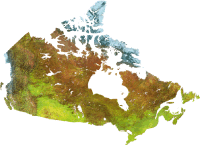 Canadian Forests Canadian Forests

This digital mosaic of Canada, produced by Natural Resources Canada (Canada Centre for Remote Sensing), is a composite of individual satellite images. The colours reflect differences in the density of vegetation cover: bright green for dense vegetation in the humid southern regions; yellow for semi-arid and mountainous regions; brown for the far north where vegetation cover is very sparse; and white for the Arctic regions.
 Natural Resources
Canada http://www.nrcan.gc.ca/inter/
Natural Resources Canada (NRCan) plays a pivotal role in helping shape the important contributions of the natural resources sector to the Canadian economy, society and environment. This sector - forests, energy, minerals and metals, and landmass, as well as related industries - is one of the most productive, high-tech sectors in the global economy. Natural Resources
Canada http://www.nrcan.gc.ca/inter/
Natural Resources Canada (NRCan) plays a pivotal role in helping shape the important contributions of the natural resources sector to the Canadian economy, society and environment. This sector - forests, energy, minerals and metals, and landmass, as well as related industries - is one of the most productive, high-tech sectors in the global economy.
 State of Canada's
Forests http://www.nrcan-rncan.gc.ca/cfs-scf/national/what-quoi/sof/latest_e.html
Canadians want assurance that the economic, environmental and social values they deem important are reflected in the management of their forests now and in the future. The long-term timber supply and the competitiveness of the forest sector; the impacts of climate change; the conservation and protection of forest ecosystems; and the integration of non-timber values are just some of the issues Canadians want addressed in a comprehensive, accurate, and coordinated fashion. They also want to be involved in meaningful forest dialogue and have access to sound, timely, and comprehensible forest information.
The State of Canada’s Forests 2002-2003 provides a glimpse into what Canada’s forest sector may look like in the future based on an exploration of some the latest economic, social and environmental trends and issues in public participation, non-timber forest values, science and innovation, international cooperation, and forest education. State of Canada's
Forests http://www.nrcan-rncan.gc.ca/cfs-scf/national/what-quoi/sof/latest_e.html
Canadians want assurance that the economic, environmental and social values they deem important are reflected in the management of their forests now and in the future. The long-term timber supply and the competitiveness of the forest sector; the impacts of climate change; the conservation and protection of forest ecosystems; and the integration of non-timber values are just some of the issues Canadians want addressed in a comprehensive, accurate, and coordinated fashion. They also want to be involved in meaningful forest dialogue and have access to sound, timely, and comprehensible forest information.
The State of Canada’s Forests 2002-2003 provides a glimpse into what Canada’s forest sector may look like in the future based on an exploration of some the latest economic, social and environmental trends and issues in public participation, non-timber forest values, science and innovation, international cooperation, and forest education.
 World Wildlife Fund Mid
Continental Canadian Forests http://www.worldwildlife.org/wildworld/profiles/terrestrial/na/na0608_full.html
The mid-continental Canadian forest ecoregion extends from southern Great Slave Lake in NWT to encompass most of northeastern Alberta, central Saskatchewan and parts of west-central Manitoba. This ecoregion is classified as having a subhumid mid-boreal
ecoclimate. It is marked by short, cool-to-warm summers and long, cold winters. World Wildlife Fund Mid
Continental Canadian Forests http://www.worldwildlife.org/wildworld/profiles/terrestrial/na/na0608_full.html
The mid-continental Canadian forest ecoregion extends from southern Great Slave Lake in NWT to encompass most of northeastern Alberta, central Saskatchewan and parts of west-central Manitoba. This ecoregion is classified as having a subhumid mid-boreal
ecoclimate. It is marked by short, cool-to-warm summers and long, cold winters.
|